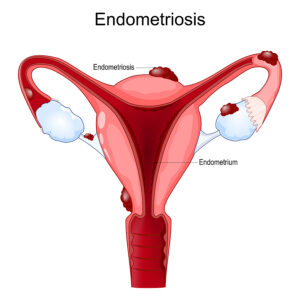There is help for endometriosis. Endometriosis can be a painful condition, but help for endometriosis is available. Dr. John Lee knew many decades ago that endometriosis was a condition where women were estrogen dominant. A few years ago, the pharmaceutical industry developed an injectable medication with the name “Lupron”. It suppresses FSH production in the pituitary gland. This reduces the estrogen production because of the inhibitory effect of the lowered FSH level on the ovaries. As a result, endometrium lesions recede and this helps the pain associated with endometriosis. Lupron Depot required injection every three months for a period of one year.
Some of the side effects of Lupron are: night sweats, tiredness, headache, upset stomach, breast changes, acne, joint/muscle aches, trouble sleeping, reduced sexual interest, vaginal discomfort/dryness and others.
Balance between estrogen and progesterone
Dr. John Lee introduced treatment of endometriosis with bioidentical progesterone cream. This has no side effects, because it is a natural hormone that the body knows. The endometrial lesions need a surplus of estrogen to cause the symptoms of endometriosis. With replacement of progesterone, there is the usual balance between estrogen and progesterone. This allows the normal mucous membrane lining of the uterus to grow, but does not support the endometrial lesions. They slowly recede and dissolve while the woman’s endometriosis symptoms disappear.
Surgical therapy for endometriosis
Laparoscopic surgery is the standard today. With this method a small incision at the lower end of the navel allows for insertion of the laparoscope through which the surgeon can see the operative field. Another small incision admits a second probe through which the surgeon can do cautery and minor surgery. The endometrial lesions are mostly cauterized. Following the laparoscopic procedure, the woman may be put on Prometrium, a bioidentical progesterone hormone.
Endometriosis and fertility
Medicine knew for a long time that women with endometriosis have a fertility problem. When all the visible endometriosis lesions are cauterized with laparoscopy and the woman is put on bioidentical progesterone, fertility often returns. Some women who have a lot of endometriosis lesions, stay infertile for the rest of their reproductive life.
Conclusion
Endometriosis is a chronic condition where patches of endometrial lining grow outside of the womb. This can cause pelvic pain and infertility. In this condition estrogen levels show elevation while progesterone levels are low. Dr. John Ott called this estrogen dominance. Medical therapy consists of laparoscopic removal of endometrial lesions. In addition, many physicians prescribe bioidentical hormone replacement of progesterone. Some women regain fertility with these treatments, but others do not. While the treatment is not perfect, most women do improve with regard to their pelvic pain.







